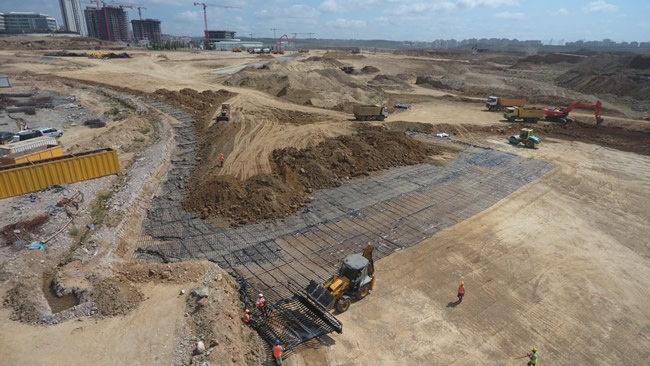The Cité des Electriciens is the oldest mining place in Nord-Pas-de-Calais, the northern most area of France. Mining activities and homes for mining workers were present from the 1850s through the 1970s, after which time the residences were abandoned. The historical prominence of the mining basin to the region led to the Cité of Electriciens being named an UNESCO World Heritage Site. After the popular 2008 film Bienvenue chez les Ch’tis (Welcome to the Sticks) introduced many international viewers to the beauty of the area, the City of Bruay le Bruissière sought to transform the historic site into a place of true cultural reference.
In 2019, this major urban project will be finalized. The impressive redevelopment includes an interpretation center, shared gardens, performance halls, artist residencies, and gites (holiday homes).
Bringing this reclamation project to fruition was not a simple engineering task, though. The presence of mining cavities increased the risk of soil collapse. Foundation security was a primary point of focus in the design. Maccaferri contributed its geosynthetic design expertise and supplied the project with geogrid reinforcement to improve the overall foundation security while greatly reducing the need for expensive fill.
FOUNDATION SECURITY WITH GEOGRIDS
To counter the risk cavity collapse, numerous strategies were utilized, the most notable of which were fill and reinforcement. At the building level, a general fill was carried out. As expected, fill alone became a costly approach, and soon enough the project was exceeding its budget for fill with many zones left to be improved.
RELATED: Transforming an Abandoned Mine into a Green Zone

Access and parking zones needed to be protected too. Here, Maccaferri was brought in. The company offered a basal reinforcement solution using ParaLink® and ParaGrid® geogrids.
The very high tensile strength of ParaLink® geogrids allowed them to be installed at the base of embankments for the site, which helped the site control what had been rising costs.
With this design, the geogrids disperse the weight of the embankments and the rolling loads of potential cavity activity. It is a “parachute” solution, one that will prevent total collapse from the surface. The solution is not only highly effective but cheaper and more environmentally friendly than using an enormous amount of fill.
Key foundation security uses of geogrid on site:
- In the bus parking zone, ParaLink® 600 was installed in tailor-made rolls of lengths from 110 to 150m. The design included a load corresponding to a weight of 32 tons on the cavity (two buses).
- For pedestrian paths, ParaGrid® 100 is used to limit the surface deflection to 45 cm in the event of a cavity ascent of 3m in diameter
PARALINK & PARAGRID: WHAT’S THE DIFFERENCE?
Both geogrids are unique planar structures, the strips for which feature a core of high-tenacity polyester yarns/tendons encased in a polyethylene sheath. Where they differ:
- ParaLink® geogrids are characterized by a monoaxial array of composite geosynthetic strips.
- ParaGrid® geogrids feature a biaxial array of composite geosynthetic strips
The materials have been used widely around the world for many years and offer 120-year design lives and high performance. They are BBA certified (British Board of Agreement) and NTPEP qualified (National Transportation Product Evaluation Program).
Learn more about Cité des Electriciens foundation security work, geosynthetic reinforcement design, and more at www.maccaferri.com.












